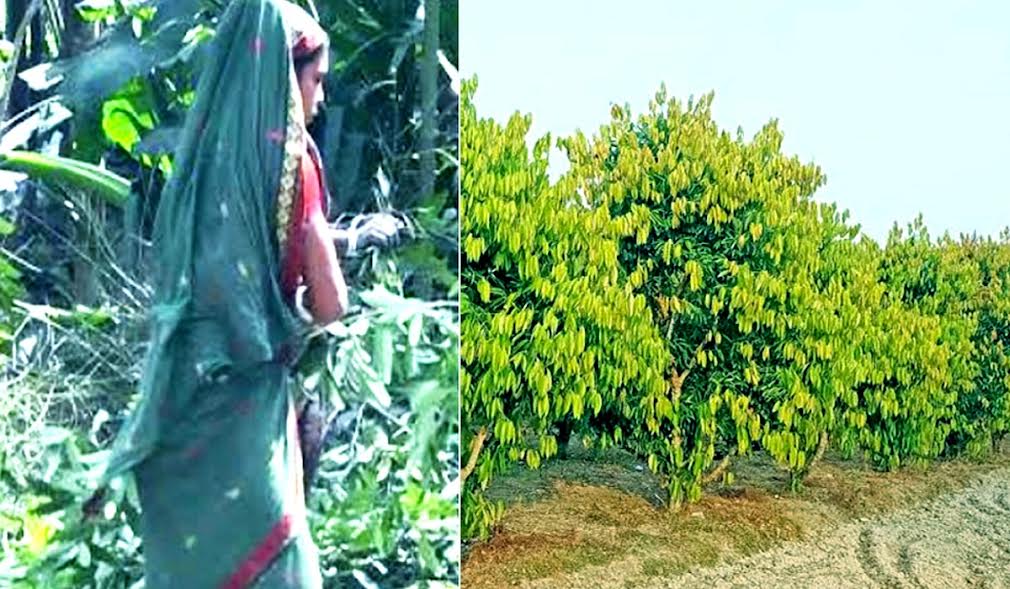News Flash
News Flash

By Md Mamun Islam
RANGPUR, Oct 3, 2025 (BSS) - Cultivation of the medicinal and spicy plant bay leaf has become popular, changing the fate of farmers in several villages of Tepamadhupur union in Kawnia upazila of Rangpur in recent years.
Almost every house in Bajemjakur, Tepamadhupur, Chaitar Mour, Rajib and adjoining villages of the union has a bay leaf garden.
Throughout the year, family members, including men, women, and teenagers, in these villages can be seen filling sacks with bay leaves every day after planting and caring for them and handing them over to traders.
While visiting Bajemjakur, Tepamadhupur, Chaitar Mour and Rajib villages recently, this reporter witnessed such a busy schedule around bay leaf gardens.
According to local villagers, many people used to plant bay leaves in their courtyards to meet the family needs of the spicy leaves at one time in Rangpur villages.
Since the profit from paddy cultivation is low, many people are becoming interested in bay leaf cultivation.
Bay leaves produced commercially in different villages of Kawnia upazila are being sent across the country and more than 20 countries including the Kingdom of Saudi Arabia, United Arab Emirates (UAE), Malaysia and Singapore.
Due to the huge demand and good market price, the spicy bay leaves are now being cultivated commercially in different areas of the upazila.
Md Abu Sufian, a farmer from Rajib village of the upazila, said that he planted 333 bay leaf plants on 66 decimals of land, spending Taka 30,000, a few years ago.
"So far, I have earned Taka two lakh and hope to earn more every year in the future," he said.
Farmer Mohammad Ashraful Islam of the same village has now grown a bay leaf garden on the land where he used to grow various vegetables including rice and jute.
"Bay leaf cultivation requires less effort and cost than rice and jute cultivation. Besides, it is more profitable than other crops," he said.
Farmers Abdur Rahman of Bajemjkur village said that many farmers in the upazila have now focused on bay leaf cultivation.
"To grow a bay leaf garden, the land needs to be cultivated minimally. The seedlings are planted with organic fertilizer and a small amount of chemical fertilizer. Each medium sized tree produces 25 to 40 kg of leaves per year."
Local farmers said that traders from different parts of the country come to buy raw bay leaves from the garden. In addition, the leaves of the entire garden can be sold under contract to traders. Various commercial group of companies purchase bay leaves from different villages.
Mohammad Rafiqul Islam, a wholesale trader in the Chaitar Mour area, said, "I buy 300 sacks of bay leaves from Kawnia upazila every week and send them to Dhaka. I sell bay leaves for Taka 108-112 per kg."
He said that exporters from Dhaka send the bay leaves to more than 20 countries around the world, including the Kingdom of Saudi Arabia, UAE, Malaysia and Singapore.
"The demand for bay leaves from Kawnia is high because of the good quality. Bay leaves are sold all year round," he added.
Talking to BSS, Sub-assistant Agriculture Officer of Rajib Block in Tepamadhupur union of the Department of Agricultural Extension (DAE) Md Anwar Hossain said that bay leaves have been cultivated on more than 60 hectares of land in the union alone.
"Deep sandy loam and loam soils are ideal for bay leaf cultivation. Bay leaves can be harvested 4-5 years after planting. Leaves can be harvested from a tree for up to a hundred years," he said.
Kawnia Upazila Agriculture Officer Krishibid Most Tania Akhter said that there are bay leaf gardens in various villages of Kawnia upazila. Farmers sell bay leaves round the year from these gardens.
Bay leaf, a medicinal and spice plant, has many medicinal properties. It is used as herbal medicines. The climate of this region is suitable for bay leaf cultivation.
"The DAE is encouraging farmers to cultivate bay leaf along with other crops including rice, jute, and potatoes and vegetables, without leaving uncultivated land to reap maximum profits," she said.